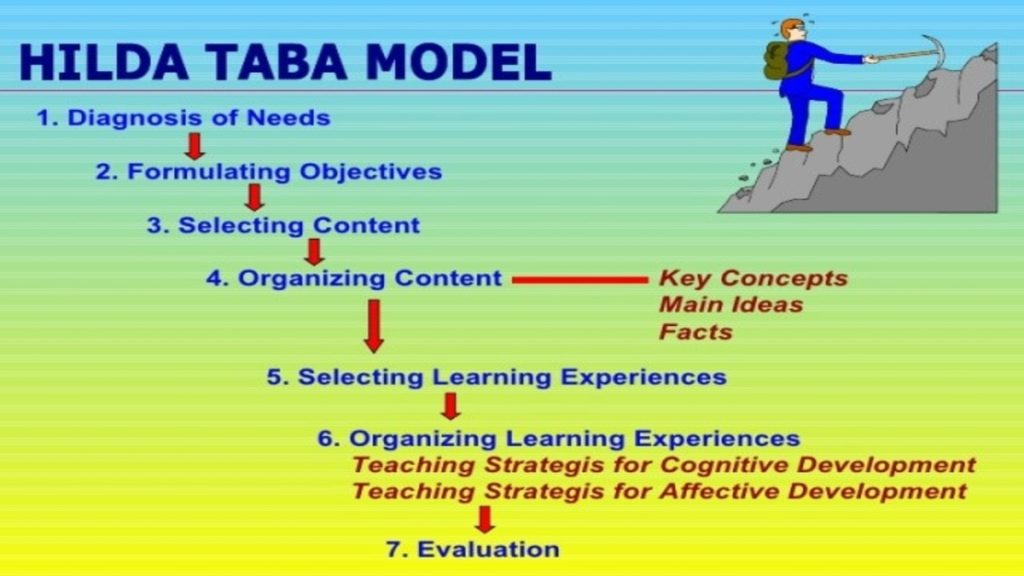Hilda Taba (7 December 1902 – 6 July 1967) was an architect, a curriculum theorist, a curriculum reformer, and a teacher educator. She wrote many books, especially in education, including The Dynamic of Education (1932), Adolescent Character and Personality (1949), School Culture: Studies of Participation and Leadership(1955), Action Research: A case study(1957), Curriculum Development and Practice (1962), Thinking in Elementary School Children(1964) etc.
Taba contributed to the theoretical and pedagogical foundation of concept development and critical thinking in social studies curriculum and helped to lay the foundation of education. She also created a multipurpose teaching model that utilizes the use of multiple process i.e. Listing, grouping, re-grouping, labelling, and synthesizing. Her model “Grassroot approach” is modified version of Tyler’s model.
Taba’s definition of Curriculum
Taba defines ‘curriculum’ as a document containing a statement of the aims and of the specific objectives; it indicates some selection and organization of content; it either implies or manifests certain patters of learning and teaching. Because the objective demand or the content organization requires it includes a program of evaluation of the outcomes.
Steps of Hilda Taba model of Curriculum Development
Hilda Taba is the developer of this model of learning. Taba believed that there is a definite logical and sequential order in creating a curriculum. She promotes the “Down-Top model” or Grassroots approach. Taba’s grassroots model has seven steps as listed below, advocating a major role for teachers.
1. Diagnosis of Learners’ Needs:-
The teacher who is also the curriculum designer starts the process by identifying the needs of the students for whom curriculum is to be planned. For example; Majority of students are unable to think critically.
2. Formulation of Objectives:-
After the teacher has identified the needs of learners that require attention, he or she specifies the objectives by which needs will be fulfilled.
3. Selection of the Content:-
The objectives selected or created suggest the subject matter or content of the curriculum. Not only objectives and content should match, but also the validity and significance of the chosen content need to be determined. i.e. the relevance and significance of the content.
4. Organization of the Content:-
A teacher cannot just select content but must organize it in a Particular Sequence taking into consideration the maturity of learners, their academic achievement and their interests.
5. Selection of Learning Experiences:-
The is supposed to present the content to the students so efficiently that the learners actively engage with the content. At this point teacher should select appropriate instructional methodology that will involve the students with the content.
6. Organization of Learning Activities:-
The teacher should organize learning activities in a sequence depending both on content sequence and learners’ characteristics. The teacher needs to keep in mind the students he or she will be teaching.
7. Evaluation:-
The curriculum planner i.e. the teacher must determine what objectives have been accomplished. To assess the achievement of learning objectives, evaluation procedures need to be designed.
Strengths of using the Taba Model
- This model taps into higher-order thinking skills.
- Builds comprehension skills such as inference, synthesizing and summarizing.
- Gifted learners will thrive with the opportunities to explore questions with multiple correct answers.
- Questioning is open ended, No clear right or wrong response.
- When grouped together students work collaboratively with others to build speaking and listening skills.
- Provides an opportunity for healthy classroom discussions before and after generalizations are made.
Limitations of using the Taba Model
- Can be difficult for some students to handle the open-ended aspect of the model.
- Without clear direction it may be difficult for teachers to plan and prepare questions for the path of the students take.
- Difficult to adapt for all subjects, or at least for some types of texts.
- Texts must be chosen in advance.
OTHER RELATED POSTS
